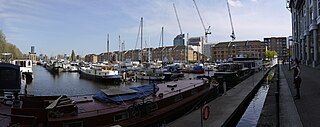
Greenland Dock is the oldest of London's riverside wet docks, located in Rotherhithe in the area of the city now known as Docklands. It used to be part of the Surrey Commercial Docks, most of which have by now been filled in. Greenland Dock is now used purely for recreational purposes; it is one of only two functioning enclosed docks on the south bank of the River Thames, along with the smaller South Dock, Rotherhithe, to which it is connected by a channel now known as Greenland Cut.
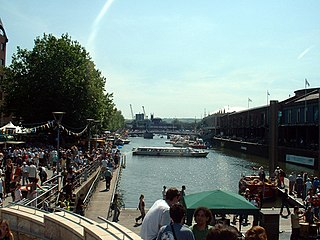
Bristol Harbour is the harbour in the city of Bristol, England. The harbour covers an area of 70 acres. It is the former natural tidal river Avon through the city but was made into its current form in 1809 when the tide was prevented from going out permanently. A tidal by-pass was dug for 2 miles through the fields of Bedminster for the river, known as the "River Avon New Cut", "New Cut", or simply "The Cut". It is often called the Floating Harbour as the water level remains constant and it is not affected by the state of the tide on the river in the Avon Gorge, The New Cut or the natural river southeast of Temple Meads to its source.
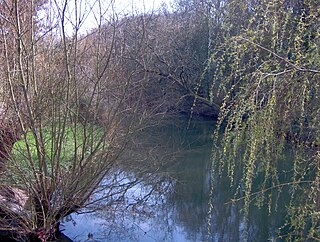
The Frome, historically the Froom, is a river that rises in Dodington Park, South Gloucestershire, and flows south westerly through Bristol, joining the former course of the river Avon in Bristol's Floating Harbour. It is approximately 20 miles (32 km) long, and the mean flow at Frenchay is 60 cubic feet per second (1.7 m3/s). The name Frome is shared with several other rivers in South West England and means 'fair, fine, brisk’. The river is known locally in east Bristol as the Danny.
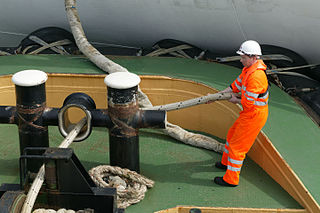
The Mission to Seafarers is a Christian welfare charity serving merchant crews around the world. It operates through a global Mission 'family' network of chaplains, staff and volunteers and provides practical, emotional and spiritual support through ship visits, drop-in seafarers centres and a range of welfare and emergency support services.

Polly Woodside is a Belfast-built, three-masted, iron-hulled barque, preserved in Melbourne, Victoria (Australia), and forming the central feature of the South Wharf precinct. The ship was originally built in Belfast by William J. Woodside and was launched in 1885. Polly Woodside is typical of thousands of smaller iron barques built in the last days of sail, intended for deep water trade around the world and designed to be operated as economically as possible.
Neva was a three-masted barque launched in 1813. She made two voyages transporting convicts to Australia. On her second voyage carrying convicts she wrecked in Bass Strait on 13 May 1835. Her loss was one of the worst shipwrecks in Australian history; 224 lives were lost.

Burrard Dry Dock Ltd. was a Canadian shipbuilding company headquartered in North Vancouver, British Columbia. Together with the neighbouring North Van Ship Repair yard and the Yarrows Ltd. yard in Esquimalt, which were eventually absorbed, Burrard built over 450 ships, including many warships built and refitted for the Royal Navy and Royal Canadian Navy in the First and Second World Wars.
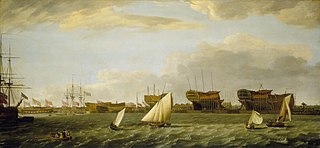
Blackwall Yard is a small body of water that used to be a shipyard on the River Thames in Blackwall, engaged in ship building and later ship repairs for over 350 years. The yard closed in 1987.
Francis Baylie was a shipbuilder based in Bristol, England, during the 17th century, a well established merchant shipbuilder who also built warships for the English Royal Navy.
Hilhouse was a shipbuilder in Bristol, England, who built merchantman and men-of-war during the 18th and 19th centuries. The company subsequently became Charles Hill & Sons in 1845.

Henry Eckford was a Scottish-born American shipbuilder, naval architect, industrial engineer, and entrepreneur who worked for the United States Navy and the navy of the Ottoman Empire in the early 19th century. After building a national reputation in the United States through his shipbuilding successes during the War of 1812, he became a prominent business and political figure in New York City in the 1810s, 1820s, and early 1830s.
Sydenham Teast (1755–1813) was a Quaker merchant, fur-trader, shipbuilder and shipowner based in Bristol, England, during the 18th and 19th centuries.

Bombay Dockyard—also known as Naval Dockyard—is an Indian shipbuilding yard at Mumbai. The superintendent of the dockyard is a Naval Officer of the rank Rear Admiral, known as the Admiral Superintendent. The current Admiral Superintendent is Rear Admiral Rajaram Swaminathan.

The New Cut is an artificial waterway which was constructed between 1804 and 1809 to divert the tidal river Avon through south and east Bristol, England. This was part of the process of constructing Bristol's Floating Harbour, under the supervision of engineer William Jessop. The cut runs from Totterdown Basin at the eastern end of St Phillip's Marsh, near Temple Meads, to the Underfall sluices at Rownham in Hotwells and rejoining the original course of the tidal Avon.
The Enmore was a wooden ship-rigged merchantman built by Green Shipbuilders in Bristol in 1858, the last known ship built by the shipyard.
John Payne Ltd was a shipbuilder in Bristol, England, who built coastal colliers and cargo ships, and small craft such as tugs, during the 19th and 20th centuries.
William Scott Shipbuilders was a short lived shipbuilder in Bristol, England in the 19th century and an early producer of steamships. The yard was important in the development of Bristol Shipbuilding with Scott's assistant, William Patterson, going on to produce the SS Great Britain.
William Patterson Shipbuilders was a major shipbuilder in Bristol, England during the 19th century and an innovator in ship construction, producing both the SS Great Western and SS Great Britain, fine lined yachts and a small number of warships.

The Pictou Shipyard is a Canadian shipbuilding site located in Pictou County, Nova Scotia, and made famous by its use as an emergency shipbuilding facility in World War II, during which it constructed twenty-four 4,700-ton Scandinavian class freighters.
Grahame Edgar Farr was a maritime historian, specialising in the history of ships and shipping in the south-west of England from the eighteenth century onwards. He also wrote about the history of the lifeboat.












